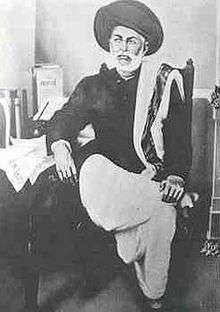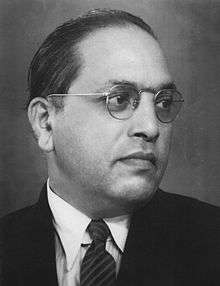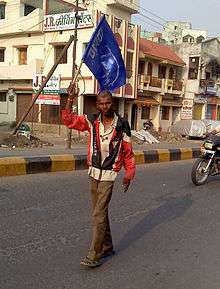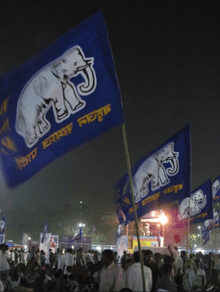Bahujan Samaj Party
Bahujan Samaj Party बहुजन समाज पार्टी | |
|---|---|
 | |
| Abbreviation | BSP |
| Leader | Mayawati |
| President | Mayawati[1] |
| Founder | Kanshi Ram |
| Preceded by | DSSSS |
| Headquarters | 12, Gurudwara Rakabganj Road, New Delhi, India-110001 |
| Ideology |
Human rights Social equality[2] Secularism Social justice[3] Self respect[4] |
| Political position | Centre-left |
| Colours | Blue |
| ECI Status | National Party |
| Seats in Lok Sabha |
0 / 545 |
| Seats in Rajya Sabha |
6 / 245 |
| Election symbol | |
 | |
| Website | |
|
www | |



The Bahujan Samaj Party (BSP) is the third largest national political party in India.[5] It was formed mainly to represent Bahujans (literally meaning "People in majority"), referring to people from the Scheduled Castes, Scheduled Tribes and Other Backward Castes (OBC), as well as religious minorities that together consist of 85 percent of India's population but still divided into 6000 different castes.[6][7]
The party claims to be inspired by the philosophy of B. R. Ambedkar, Mahatma Jyotiba Phule, Narayana Guru, Periyar E. V. Ramasamy and Chhatrapati Shahuji Maharaj.[8] It was founded by Kanshi Ram in 1984, who named his protégée Mayawati as his successor in 2001.
The BSP was the third most voted-for party in the 2014 general election but still failed to win any seats in the 16th Lok Sabha.[9] The BSP has its main base in the Indian state of Uttar Pradesh. It has an elephant as its election symbol.
Origin of the word Bahujan
The Pali word "Bahujan" is popularly found in the literature of Buddhist texts. Gautama Buddha used this word to guide his disciples to work for the Bahujan Hitay Bahujan Sukhay (tran. Benefit and prosperity of majority people).[10][11][12] The BSP used this slogan extensively to campaign in her political rallies.[13]
History
Strategy
The Bahujan Samaj Party was founded on the birth anniversary of B.R. Ambedkar (i.e. 14 April 1984) by Kanshi Ram,[14] who named former schoolteacher Mayawati as his successor in 2001.[15]
Speaking of lesser-known figures from the Indian Rebellion of 1857 who have been used as Dalit icons by the BSP, such as Chetram Jatav, the social scientist Badri Narayan Tiwari has noted that
Dalit intellectuals supported by BSP, which is trying to mobilise grassroot Dalits using local heroes, histories, myths and legends found a wealth of resources in the oral history of the regions of [Uttar Pradesh] centering around the 1857 rebellion. The political strategy of the party is to tell and retell the stories of these heroes, build memorials and organize celebrations around their stories repeatedly to build a collective memory in the psyche of the people. The stories are narrated in such a manner that the Dalits imagine the story of the making of this nation in which they played a significant role.[16]
Development
The party's power grew quickly with seats in the Legislative Assembly of Uttar Pradesh and the Lok Sabha, the lower house of the Parliament of India. In 1993, following the assembly elections, Mayawati formed a coalition with Samajwadi Party President Mulayam Singh Yadav as Chief Minister. On 2 June 1995, she withdrew support from his government, which led to a major incident where Yadav was accused of sending his goons to keep her party legislators hostage at a Lucknow guest house and shout casteist abuses at her.[17] Since this event, they have regarded each other publicly as chief rivals.[18]
Mayawati then obtained support from the Bharatiya Janata Party (BJP) to become Chief Minister on 3 June 1995. In October 1995, the BJP withdrew their support and fresh elections were called after a period of President's Rule. In 2003, Mayawati resigned from her own government to prove that she was not "hungry for power"[19] and asked the BJP-run Government of India to remove Union Tourism and Culture Minister, Jagmohan.[20] In 2007, she began leading a BSP-formed government with an absolute majority for a full five-year term.[21]

Success in 2007
The results of the May 2007 Uttar Pradesh state assembly election saw the BSP emerge as a sole majority party, the first to do so since 1991. Mayawati began her fourth term as Chief Minister of Uttar Pradesh and took her oath of office along with 50 ministers of cabinet and state rank on 13 May 2007, at Rajbhawan in the state capital of Lucknow.[22] Most importantly, the majority achieved in large part was due to the party's ability to take away majority of upper castes votes from their traditional party, the BJP.[23]

The party could manage only 80 seats in 2012 as against 206 in 2007 assembly elections. BSP government was the first in the history of Uttar Pradesh to complete its full five-year term.[24] On 11 July 2012, the party in a major revamp, replaced Swami Prasad Maurya by Ram Achal Rajbhar as President of UP Unit.[25]
The 2014 national Lok Sabha elections saw the BSP become the third-largest national party of India in terms of vote percentage, having 4.2% of the vote across the country but gaining no seats.[26]
Secret successor of Mayawati
On 9 August 2009; Mayawati declared that she had chosen a successor from the Dalit community who is 18–20 years her junior. She has penned down his name in a sealed packet left in the safe custody of two of her close confidantes. The name of the successor will be disclosed on her death.[27]
Election results
Lok Sabha (Lower House)
| Lok Sabha Term | Indian General Election |
Seats contested |
Seats won |
% of votes |
% of votes in seats contested |
State (seats) |
|---|---|---|---|---|---|---|
| 9th Lok Sabha | 1989 | 245 | 4 | 2.07 | 4.53 | Punjab (1) Uttar Pradesh (3)[28] |
| 10th Lok Sabha | 1991 | 231 | 3 | 1.61 | 3.64 | Madhya_Pradesh(1) Punjab (1) Uttar Pradesh (1)[29] |
| 11th Lok Sabha | 1996 | 210 | 11 | 4.02 | 11.21 | Madhya Pradesh(2) Punjab (3) Uttar Pradesh (6) |
| 12th Lok Sabha | 1998 | 251 | 5 | 4.67 | 9.84 | Haryana (1) Uttar Pradesh (4) |
| 13th Lok Sabha | 1999 | 225 | 14 | 4.16 | 9.97 | Uttar Pradesh (14) |
| 14th Lok Sabha | 2004 | 435 | 19 | 5.33 | 6.66 | Uttar Pradesh (19) |
| 15th Lok Sabha | 2009 | 500 | 21 | 6.17 | 6.56 | Madhya Pradesh(1) Uttar Pradesh (20) |
| 16th Lok Sabha | 2014 | 503 | 0 | 4.3 | NA | |
Uttar Pradesh Vidhan Sabha (Lower House)
| Vidhan Sabha Term | UP elections |
Seats contested |
Seats won |
% of votes |
% of votes in seats contested |
|---|---|---|---|---|---|
| 12th Vidhan Sabha | 1993 | 164 | 67 | 11.12 | 28.52 |
| 13th Vidhan Sabha | 1996 | 296 | 67 | 19.64 | 27.73 |
| 14th Vidhan Sabha | 2002 | 401 | 98 | 23.06 | 23.19 |
| 15th Vidhan Sabha | 2007 | 403 | 206 | 30.43 | 30.43 |
| 16th Vidhan Sabha | 2012 | 403 | 80 | 25.95 | 25.95 |
Other states where BSP has a presence

Bihar Vidhan Sabha
| Vidhan Sabha Term | Bihar General Election |
Seats contested |
Seats won |
% of votes |
% of votes in seats contested |
|---|---|---|---|---|---|
| 10th Vidhan Sabha | 1990 | 164 | 0 | 0.73 | 1.41 |
| 11th Vidhan Sabha | 1995 | 161 | 2 | 1.34 | 2.66 |
| 12th Vidhan Sabha | 2000 | 249 | 5 | 1.89 | 2.47 |
| 13th Vidhan Sabha | Feb. 2005 | 238 | 2 | 4.41 | 4.50 |
| 14th Vidhan Sabha | Oct. 2005 | 212 | 4 | 4.17 | 4.75 |
| 15th Vidhan Sabha | 2010 | 243 | 0 | 3.21 | 3.27 |
| 16th Vidhan Sabha | 2015 | 243 | 0 | 2.1 | 2.1[30] |
Chhattisgarh Vidhan Sabha
| Vidhan Sabha Term | Chhattisgarh General Election |
Seats contested |
Seats won |
% of votes |
% of votes in seats contested |
|---|---|---|---|---|---|
| 2nd Vidhan Sabha | 2003 | 54 | 2 | 4.45 | 9.4 |
| 3rd Vidhan Sabha | 2008 | 90 | 2 | 6.11 | 6.11 |
| 4th Vidhan Sabha | 2013 | 90 | 1 | 4.27 | 4.29 |
Delhi Vidhan Sabha
| Vidhan Sabha Term | Delhi General Election |
Seats contested |
Seats won |
% of votes |
% of votes in seats contested |
|---|---|---|---|---|---|
| 1st Vidhan Sabha | 1993 | 55 | 0 | 1.88 | 2.42 |
| 2nd Vidhan Sabha | 1998 | 58 | 0 | 3.09 | 3.63 |
| 3rd Vidhan Sabha | 2003 | 40 | 0 | 5.76 | 8.96 |
| 4th Vidhan Sabha | 2008 | 69 | 2 | 14.05 | 14.05 |
| 5th Vidhan Sabha | 2013 | 69 | 0 | 5.33 | 5.44 |
| 6th Vidhan Sabha | 2015 | 70 | 0 | 1.3 | 1.3 |
Haryana Vidhan Sabha
| Vidhan Sabha Term | Haryana General Election |
Seats contested |
Seats won |
% of votes |
% of votes in seats contested |
|---|---|---|---|---|---|
| 8th Vidhan Sabha | 1991 | 26 | 1 | 2.32 | 7.67 |
| 9th Vidhan Sabha | 1996 | 67 | 0 | 5.44 | 7.2 |
| 10th Vidhan Sabha | 2000 | 83 | 1 | 5.74 | 6.22 |
| 11th Vidhan Sabha | 2005 | 84 | 1 | 3.22 | 3.44 |
| 12th Vidhan Sabha | 2009 | 86 | 1 | 6.73 | 7.05 |
| 13th Vidhan Sabha | 2014 | 87 | 1[31] | 4.37[32] | 4.52 |
Himachal Pradesh Vidhan Sabha
| Vidhan Sabha Term | Himachal Pradesh General Election |
Seats contested |
Seats won |
% of votes |
% of votes in seats contested |
|---|---|---|---|---|---|
| 7th Vidhan Sabha | 1990 | 35 | 0 | 0.94 | 1.76 |
| 8th Vidhan Sabha | 1993 | 49 | 0 | 2.25 | 3.0 |
| 9th Vidhan Sabha | 1998 | 28 | 0 | 1.41 | 3.28 |
| 10th Vidhan Sabha | 2003 | 23 | 0 | 0.7 | 2.02 |
| 11th Vidhan Sabha | 2007 | 67 | 1 | 7.40 | 7.37 |
| 12th Vidhan Sabha | 2012 | 67 | 0 | 1.7 | 2.02 |
Jammu and Kashmir Vidhan Sabha
| Vidhan Sabha Term | Jammu and Kashmir General Election |
Seats contested |
Seats won |
% of votes |
% of votes in seats contested |
|---|---|---|---|---|---|
| 9th Vidhan Sabha | 1996 | 29 | 4 | 6.43 | 15.07[33] |
| 10th Vidhan Sabha | 2002 | 33 | 1 | 4.50 | 7.86[34] |
| 11th Vidhan Sabha | 2008 | 83 | 0 | 3.73 | 3.73[35] |
| 12th Vidhan Sabha | 2014 | 50 | 0 | 1.41 | 2.07[36] |
Jharkhand Vidhan Sabha
| Vidhan Sabha Term | Jharkhand General Election |
Seats contested |
Seats won |
% of votes |
% of votes in seats contested |
|---|---|---|---|---|---|
| 3rd Vidhan Sabha | 2009 | 78 | 0 | 2.44 | 2.55[37] |
| 4th Vidhan Sabha | 2014 | 41[38] | 1[39] | 1.4 | 1.8 |
Madhya Pradesh Vidhan Sabha
| Vidhan Sabha Term | Madhya Pradesh General Election |
Seats contested |
Seats won |
% of votes |
% of votes in seats contested |
|---|---|---|---|---|---|
| 9th Vidhan Sabha | 1990 | 183 | 2 | 3.54 | 5.89 |
| 10th Vidhan Sabha | 1993 | 286 | 2 | 7.05 | 7.86 |
| 11th Vidhan Sabha | 1998 | 170 | 11 | 6.15 | 11.39 |
| 12th Vidhan Sabha | 2003 | 157 | 2 | 7.26 | 10.62 |
| 13th Vidhan Sabha | 2008 | 230 | 7 | 8.97 | 9.29 |
| 14th Vidhan sabha | 2013 | 227 | 4 | 6.29 | 6.42 |
Maharashtra Vidhan Sabha
| Vidhan Sabha Term | Maharashtra General Election |
Seats contested |
Seats won |
% of votes |
% of votes in seats contested |
|---|---|---|---|---|---|
| 8th Vidhan Sabha | 1990 | 122 | 0 | 0.42 | 0.98 |
| 9th Vidhan Sabha | 1995 | 145 | 0 | 1.49 | 2.82 |
| 10th Vidhan Sabha | 1999 | 83 | 0 | 0.39 | 1.24 |
| 11th Vidhan Sabha | 2004 | 272 | 0 | 4.0 | 4.18 |
| 12th Vidhan Sabha | 2009 | 287 | 0 | 2.35 | 2.42 |
| 13th Vidhan Sabha | 2014 | 260[40] | 0 | 2.3[41] |
Punjab Vidhan Sabha
| Vidhan Sabha Term | Punjab General Election |
Seats contested |
Seats won |
% of votes |
% of votes in seats contested |
|---|---|---|---|---|---|
| 10th Vidhan Sabha | 1992 | 105 | 9 | 16.32 | 17.59 |
| 11th Vidhan Sabha | 1997 | 67 | 1 | 7.48 | 13.28 |
| 12th Vidhan Sabha | 2002 | 100 | 0 | 5.69 | 6.61 |
| 13th Vidhan Sabha | 2007 | 115 | 0 | 4.13 | 4.17 |
| 14th Vidhan Sabha | 2012 | 117 | 0 | 4.28 | 4.28 |
Rajasthan Vidhan Sabha
| Vidhan Sabha Term | Rajasthan General Election |
Seats contested |
Seats won |
% of votes |
% of votes in seats contested |
|---|---|---|---|---|---|
| 9th Vidhan Sabha | 1990 | 205 | 0 | 0.79 | 2.54 |
| 10th Vidhan Sabha | 1993 | 50 | 0 | 0.56 | 2.01 |
| 11th Vidhan Sabha | 1998 | 108 | 2 | 2.17 | 3.81 |
| 12th Vidhan Sabha | 2003 | 124 | 2 | 3.97 | 6.40 |
| 13th Vidhan Sabha | 2008 | 199 | 6 | 7.60 | 7.66 |
| 14th Vidhan Sabha | 2013 | 199 | 3 | 3.37 | 3.48 |
Uttarakhand Vidhan Sabha
| Vidhan Sabha Term | Uttarakhand General Election |
Seats contested |
Seats won |
% of votes |
% of votes in seats contested |
|---|---|---|---|---|---|
| 1st Vidhan Sabha | 2002 | 68 | 7 | 10.93 | 11.20 |
| 2nd Vidhan Sabha | 2007 | 69 | 8 | 11.76 | 11.76 |
| 3rd Vidhan Sabha | 2012 | 70 | 3 | 12.19 | 12.19 |
Kerala Vidhan Sabha
| Vidhan Sabha Term | Kerala General Election |
Seats contested |
Seats won |
Total of votes |
% of votes |
|---|---|---|---|---|---|
| 13th Vidhan Sabha | 2011 | 122 | 0 | 104977 | 0.60 |
| 14th Vidhan Sabha | 2016 |
See also
References
- ↑ PTI (30 August 2014). "Mayawati elected BSP president for another term". livemint.com. Retrieved 2016-06-04.
- ↑ "'BSP stands for social equality'". Deccan Herald. 11 February 2008. Retrieved 2016-03-13.
- ↑ "Cong damaged cause of social justice: Mayawati". Hindustan Times. 10 April 2009. Retrieved 2016-06-04.
- ↑ "Ms. Mayawati said she would devote her life for the self-respect movement.". The Hindu.
- ↑ "Vote share: BJP gets 31 pc; 3rd largest BSP gets no seat". Rediff. Retrieved 4 October 2016.
- ↑ "We need to become ruling class if we want to form a casteless society – Saheb Kanshi Ram". drambedkarbooks.com. Bahujan Sanghatak.
- ↑ "The party figured out that if it really wants to ensure that 15 percent would not rule over the remaining 85 percent".
- ↑ "The ground flanked by giant sized cut-outs of BSP's icons -- Babasaheb Ambedkar , Shahuji Maharaj, Jyotiba Phule, Narain Guru, Periyar and Mayawati herself.".
- ↑ "Lok Sabha polls: Parties corner vote share, but fail to win seats". ZeeNews.
- ↑ "Bahujanahitasuttaṃ". Access to Insight. Retrieved 4 October 2016.
- ↑ "For the Welfare of Many". Access to Insight. Retrieved 4 October 2016.
- ↑ Madan 1999, p. 47.
- ↑ "Mayawati has announced rallies named "Bahujan Hitay Bahujan Sukhay" across the state.". The Indian Express. Retrieved 4 October 2016.
- ↑ Singh, Pitam (2003). Women legislators in Indian politics. New Delhi: Concept Pub. Co. p. 101. ISBN 8180690199.
- ↑ Pradhan, Sharat (15 December 2001). "Kanshi Ram declares Mayawati as his successor". Rediff News.
- ↑ Tiwari, Badri Narayan (2007). "Identity and Narratives: Dalits and memories of 1857" (PDF). University of Edinburgh: Mutiny at the Margins Conference: 13, 27, 33.
- ↑ "Report indicting Mulayam Singh Yadav comes handy for BJP". India Today. 15 August 1996. Retrieved 2016-05-12.
- ↑ Ghildiyal, Subodh. "Why Mayawati cannot stand Mulayam".
- ↑ "Uttar Pradesh chief quits". BBC News. 26 August 2003. Retrieved 2016-03-25.
- ↑ "Mayawati offers to resign". The Times of India. 25 August 2003. Retrieved 2016-03-25.
- ↑ "Mayawati rules Uttar Pradesh". India Today. 21 May 2007. Retrieved 2016-03-25.
- ↑ "Mayawati takes oath as UP CM". NDTV.
- ↑ "Upper castes played crucial role in bsp victory in up assembly elections".
- ↑ http://eciresults.nic.in/PartyWiseResult.htm
- ↑ "BSP replaces U.P. chief". The Hindu. Chennai, India. 12 July 2012.
- ↑ "BSP gets third-largest vote share, but no seat". Business Standard.
- ↑ "Mayawati talks of the secret successor : India". Nerve.in. Retrieved 2012-07-12.
- ↑ "Members : Lok Sabha". IIS Windows Server. 2 May 2016. Retrieved 2016-05-02.
- ↑ "Members : Lok Sabha". IIS Windows Server (in Javanese). 2 May 2016. Retrieved 2016-05-02.
- ↑ "Bihar polls: In NDA vs Grand Alliance fight, BSP fails to make mark".
- ↑ "Tek Chand Sharma won the lone seat for the party from the Prithla seat in Faridabad by a margin of 1,179 votes". Hindustan Times.
- ↑ "ELECTION COMMISSION OF INDIA GENERAL\BYE ELECTION TO LEGISLATIVE ASSEMBLIES TRENDS & RESULT 2014".
- ↑ "1996 - Election Commission of India" (PDF).
- ↑ "STATISTICAL REPORT ON GENERAL ELECTION, 2002" (PDF).
- ↑ "BSP have failed to make a mark". Hindustan Times.
- ↑ "STATISTICAL REPORT ON GENERAL LECTION,2014 TO THE LEGISLATIVE ASSEMBLY OF Jammu & Kashmir" (PDF).
- ↑ "2009 - Election Commission of India" (PDF).
- ↑ "41 in Jharkhand". Archived from the original on 28 December 2014.
- ↑ "Bahujan Samaj Party makes debut with 1/81 score". Indian Express.
- ↑ "BSP had contested on 260 seats in Maharashtra.". Daily Bhaskar.
- ↑ "ELECTION COMMISSION OF INDIA GENERAL\BYE ELECTION TO LEGISLATIVE ASSEMBLIES TRENDS & RESULT 2014". Archived from the original on 3 November 2014.
External links
| Wikimedia Commons has media related to Bahujan Samaj Party. |